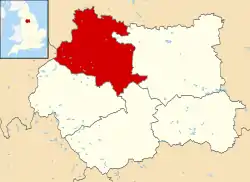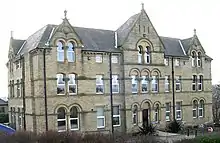Bradford smallpox outbreak of 1962
An outbreak of smallpox in Bradford in 1962 first came to attention on 11 January 1962, when a cook from the children's hospital in Bradford, West Riding of Yorkshire, England, presented with an unexplained fever and was found to have changes in her blood similar to another sick person at the nearby St Luke's Hospital, both samples appearing compatible with smallpox. The index case was later discovered to be a nine-year old girl who arrived in the UK on 16 December 1961 from Karachi, Pakistan, where there was an ongoing epidemic of smallpox.
| Bradford smallpox outbreak of 1962 | |
|---|---|
.jpg.webp) Bradford Children's Hospital, where the index case was admitted | |
 Shown within West Yorkshire | |
| Location | Bradford, UK |
| First reported | 11 January 1962 |
| Index case | Nine year old girl from Karachi |
| Arrival date | 16 December 1961 |
| Date | 1961-12 February 1962 |
Type | Smallpox |
| Confirmed cases | 14 |
Deaths | 6 |
The outbreak resulted in 14 cases of smallpox, contact tracing of over 1,400 individuals, vaccination of over 200,000 (either 250,000 or 285,000) people and six deaths directly due to the disease. It was officially declared over on 12 February 1962.
Background
Between December 1961 and April 1962, authorities became aware of an ongoing epidemic of smallpox in Karachi, where people were able to depart via charter flight and arrive in the UK, where surveillance at airports was enhanced only following the first imported case.[1][2] At the time, Bradford was a major destination for those seeking work in mills and factories. Of the city's 298,000 people, 1,000 were West Indian, 2,000 from India and 7,500 from Pakistan. In Roberta Bivins' account of the epidemic published in 2015, she described Bradford as having "prided itself on a reputation for tolerance and good intercommunal relations".[3]
On 10 January 1962, a case of smallpox was confirmed in a man who had arrived at Heathrow Airport, London, on Christmas Day. Another suspected case arrived from Pakistan on 19 December 1961. On 1 January 1962, a contact of the first case arrived in Bradford and was immediately isolated.[4] In all, of the five people with smallpox that had arrived at Heathrow from Pakistan, two went on to Birmingham, one to Cardiff, one to Bradford and one stayed in London.[1] In Bradford's preparedness, a local hospital was designated for further possible cases of smallpox.[4]
Outbreak
On 11 January 1962, shortly after being appointed consultant pathologist at St Luke's Hospital in Bradford, pathologist Derrick Tovey received two almost identical severely abnormal blood samples from two unrelated people who had been admitted with unexplained fevers to two different hospitals, unusually on the same day. One case was Hettie Whetlock, a 49 year old cook from Bradford Children's Hospital, who was under observation at the Leeds Road Fever Hospital. The other was Jack Crossly, a 40-year-old abattoir worker who had been admitted to Tovey's own hospital, St Luke's, and who died shortly after the blood was taken. Tovey described the samples as showing "a mild anaemia, leucopenia, thrombocytopenia and a striking blood film with nucleated red cells, myelocytes, fragmenting granulocytes and vacuolation of the protoplasm, condensed nuclear bodies and atypical plasma cells and some Türck cells". The findings were similar to a description of smallpox as reported by Kano Ikeda in 1925. After examining the man in the mortuary and without waiting for laboratory confirmation, the diagnosis was assumed and the regional medical officer convened a committee.[4][5][6] One nurse[7] and five children from A1 ward at the Bradford Children's Hospital were shortly suspected of having smallpox. One of these children had already been transferred to Wharfedale Hospital for observation. The result was that four hospitals were initially quarantined.[8] All cases were transferred to Oakwell Hospital, the designated isolation hospital in Birstall.[9][10]
The following day the index case was discovered to be a nine-year old girl who arrived in the UK on 16 December 1961 from Karachi.[11] Her international vaccination certificates were up-to-date and when she was admitted to A1 ward at Bradford's Children's Hospital, her diagnosis and treatment of malaria masked any suspicion of smallpox. She subsequently died on 30 December 1961. During that Christmas period, A1 ward had been visited by Whetlock and Crossby, who had a child as an inpatient at the hospital.[4][5] Norman Ainley,[5][12] the pathologist who performed the postmortem at the Bradford Royal Infirmary on the nine-year old girl had not been vaccinated, contracted the illness and died within a few days, leaving the Royal Infirmary as the fifth hospital to be quarantined.[2][4][7] At Oakwell, two of the five transferred children died.[5] By mid-January, five of the 10 second generation cases died and all of Bradford's hospitals had closed to non-urgent cases.[5]
Hospitals involved
 Bradford Children's Hospital
Bradford Children's Hospital St. Luke's Hospital.
St. Luke's Hospital. Leeds Road Fever Hospital.
Leeds Road Fever Hospital. Old Wharfedale Hospital.
Old Wharfedale Hospital. Bradford Royal Infirmary.
Bradford Royal Infirmary.
Response
Contact tracing, vaccination and surveillance
The responsibility for tracing contacts, vaccination and surveillance of hospital staff and patients was designated to one medical officer at each hospital.[8] Tovey became the “control of infection” for St. Luke's.[6] Bradford's medical officer of health at the time was John Douglas.[8][13] Neighbouring authorities were notified within 48 hours.[2] Authorities carried out contact tracing of over 1,400 individuals and public demand led to the vaccination of either 250,000[2] or 285,000 people[4] over five days, despite as Douglas confirmed in 1962, that "mass vaccination was at no stage recommended".[1][2][8][14] A number of people experienced minor symptoms as side effects from the vaccine; at least six had severe symptoms and one man with pre-existing medical conditions died. One death occurred in a child, who had not been vaccinated, but had contracted smallpox after having been in a bath with her vaccinated sister.[4]
Business
The outbreak resulted in the closing of shops with a consequent drop in earnings. Cafes, cinemas and theatres closed and football was postponed.[11][15]
Media
On 12 January 1962, the Telegraph & Argus, Bradford's local daily newspaper, reported "Smallpox Fear: 2 Die". The following day after a child had died from smallpox in hospital, the paper reported "Panic measures not needed". Bivins' described that the Argus was "careful not to exaggerate the role of immigration", noted the paper to frequently quote medical authorities, acknowledged that it reported that Pakistani residents were just as vulnerable and that Pakistan itself had been implementing its own vaccination measures.[3] In contrast, papers such as The Yorkshire Post alleged that "most Bradfordians were angry", a claim the Argus denied.[3] The epidemic was covered by Pathé newsreels.[3] With media attention on health checks for immigrants, the outbreak became a focus of discussion in the months leading to the Commonwealth Immigrants Act 1962.[16]
Outcome
Of the 11 cases treated in hospital, one 77 year old man had been vaccinated as a child; the others were unvaccinated.[7] In all, the outbreak resulted in 14 cases of smallpox and six deaths directly due to the disease. It was officially declared over on 12 February 1962.[2][3] After including the cases in the rest of England and Wales during this time, it was reported that there were 62 local cases of smallpox, 16 in England and 46 in Wales. 40 cases were in hospitals and there were 24 deaths.[1]
Recollections
In 2014, in a letter published in The Telegraph, the person who nursed the girl from Pakistan, recalled that due to it being Christmas "contact between child patients was unusually high because they were carried around the wards to look at Christmas trees and decorations" and upon recognising the outbreak "Everyone in the hospital was immediately quarantined".[17]
References
- Pennington, Hugh (2003). "Smallpox and bioterrorism" (PDF). Bulletin of the World Health Organization. 81 (10): 765. PMC 2572332. PMID 14758439.
- Pollock, George (30 March 2012). An Epidemiological Odyssey: The Evolution of Communicable Disease Control. Springer Science & Business Media. pp. 53–. ISBN 978-94-007-3998-7.
- Bivins, Roberta E. (2015). "3. Smallpox, 'Social Threats", and Citizenship, 1961-1966". Contagious Communities: Medicine, Migration, and the NHS in Post-war Britain. Oxford University Press. pp. 140–147. ISBN 978-0-19-872528-2.
- Tovey, Derrick (May 2004). "The Bradford smallpox outbreak in 1962: a personal account". Journal of the Royal Society of Medicine. 97 (5): 244–247. doi:10.1258/jrsm.97.5.244. ISSN 0141-0768. PMC 1079469. PMID 15121819.
- Pallen, Mark (2018). "10. Bradford 1962". The Last Days of Smallpox; Tragedy in Birmingham. pp. 29–32. ISBN 9781980455226.
- Gulland, Anne (23 December 2015). "Derrick Tovey" (PDF). British Medical Journal. 351: h6953. doi:10.1136/bmj.h6953. ISSN 1756-1833. S2CID 220093569.
- Benn, E C (1 May 1963). "Smallpox in England and Wales 1962: Smallpox in Bradford 1962: A Clinical Review". Proceedings of the Royal Society of Medicine. 56 (5): 343–345. doi:10.1177/003591576305600503. ISSN 0035-9157.
- Douglas, John; Edgar, William (3 March 1962). "Smallpox in Bradford, 1962". British Medical Journal. 1 (5278): 612–614. doi:10.1136/bmj.1.5278.612. ISSN 0007-1447. PMC 1957680. PMID 13887541.
- "Oakwell Hospital, Birstall (Hansard, 26 February 1962)". api.parliament.uk. Retrieved 16 August 2020.
- U.S. Navy Medicine. U.S. Bureau of Medicine and Surgery. 1962. p. 29.
- "Smallpox (Hansard, 15 February 1962)". api.parliament.uk. Retrieved 1 May 2020.
- Logan, J. S. (October 1993). "A memoir of Dr Norman Joseph Ainley (1924-1962), and a last look at smallpox and vaccination". The Ulster Medical Journal. 62 (2): 145–152. ISSN 0041-6193. PMC 2449039. PMID 8303798.
- "Obituary; John Douglas". British Medical Journal. 304: 1242. 9 May 1992.
- Millward, Gareth (2019). Vaccinating Britain: Mass vaccination and the public since the Second World War. Manchester University Press. p. 58. ISBN 978-1-5261-2675-7.
- Parker, Simon (13 April 2020). "Looking back: When Bradford sport was shut down by smallpox". Bradford Telegraph and Argus. Retrieved 15 August 2020.
- Butterworth, Eric (1 April 1966). "The 1962 Smallpox Outbreak and the British Press". Race. 7 (4): 347–364. doi:10.1177/030639686600700403. ISSN 0033-7277. S2CID 144121490.
- "The control of Ebola should draw on the experience of Britain's last smallpox outbreak". Daily Telegraph. 10 October 2014. ISSN 0307-1235. Retrieved 16 August 2020.(subscription required)
Further reading
- Bivins, Roberta (1 November 2007). ""The People Have No More Love Left for the Commonwealth": Media, Migration and Identity in the 1961–62 British Smallpox Outbreak". Immigrants & Minorities. 25 (3): 263–289. doi:10.1080/02619280802407376. ISSN 0261-9288. PMC 2899858. PMID 20622927.
External links
- Smallpox outbreak in Bradford (1962)
- Secure against smallpox. Granada TV footage (Director: Geoffrey Warnes) 1967